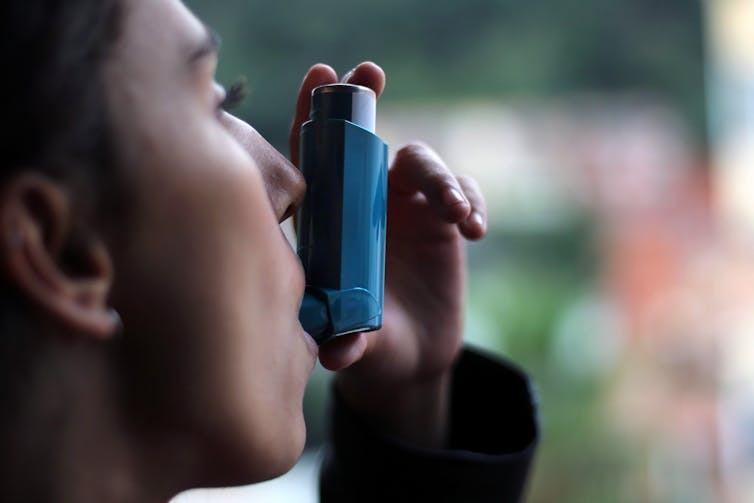
Climate change has caused melting icebergs, flooding, and landslides. It can also bring about an increase in pollen levels, prolong the duration of pollen season, and cause more pollen-related health problems.
Pollen grains landing on the moist membranes of the nose or eyes cause “hay fever” (allergic rhinitis) in one in five people. This often leads to a runny or blocked nose and itchy eyes.
During the pollen season, people with asthma are at greater risk of a flare-up.
Pollen can also trigger thunderstorm asthma, even in those who haven’t been diagnosed with asthma and hay fever.
What is thunderstorm asthma?
Thunderstorms cause a drop in temperature and a sudden rise in humidity. This can cause whole grass pollen grains to rupture into particles that are tiny enough to penetrate deeper into the lungs, which causes thunderstorm asthma.
Because of this, a lot of people – even those with no known asthma – can be affected.
The largest thunderstorm asthma event occurred in Melbourne during the 2016 grass pollen season – some 10,000 people were affected and hospital emergency departments were over-capacity by at least 3,000 respiratory-related cases. Sadly, ten people also died from asthma that night.
Who is at risk of thunderstorm asthma?
Even people who do not have a history of asthma are at risk of thunderstorm asthma. However, research has shown some people can be more susceptible to pollen than others. This includes:
- those with pollen allergy, specifically ryegrass pollen allergy
- people who have respiratory conditions such as asthma, hay fever, a cold, and COVID
- being outdoors at the time of the thunderstorm
- people who are of Asian ethnicity
- people living in areas with lots of plant life
- children with a food allergy or eczema
- those with exposure to high levels of air pollution
- those with lower socioeconomic status, as reduced access to health care and poor quality housing can exacerbate symptoms.
In our research, we found people with co-existing allergic conditions (such as asthma and hay fever) to be more impacted by pollen compared to those with single allergic conditions (such as asthma only).
How else can pollen cause harm?
Even outside of thunderstorms, pollen alone can cause asthma attacks requiring hospitalisations, respiratory symptoms such as wheezing and runny nose, and reduced lung function, making it harder to breath.
Despite a low mortality rate, allergic asthma and hay fever can cause further burdens such as additional health-care costs and poorer physical and mental health.
Our yet-to-be-published research has shown grass pollen may trigger a general state of heightened immune responses, leading to increased risk of eczema flares in children.
Other studies have indicated children with eczema experience more symptoms such as a higher intensity of itchiness and rash on days with high levels of grass pollen.
Read more: Sneezing with hay fever? Native plants aren't usually the culprit
How can you prepare?
So, what can you do to prepare for the grass pollen season and the threat of thunderstorm asthma?
- download your state’s emergency services app, such as the Victorian Emergency App, which can provide thunderstorm asthma alerts
- keep an eye on pollen counts (see below for useful websites)
- keep doors and windows closed on high pollen days
- use air purifiers
- stay indoors during high pollen counts or thunderstorm asthma alerts
- plant non-allergenic flowers if you have a garden
- keep wearing a face mask. Masks have shown to be very effective in reducing the risk of COVID-19 infection and pollen-induced respiratory symptoms
- take anti-asthma medications. Reliever medications are available over-the-counter. Preventer medications offer much stronger protection but require a prescription from a doctor. They also need to be used preventatively in the setting of pollen-induced asthma, or in severe hay fever, to prevent thunderstorm asthma
- take antihistamines such as Zyrtec, which can be used both on an as-needed basis or more regularly through the pollen season. However, it does not treat or prevent asthma.

If you know you suffer from asthma, hay fever or pollen allergy, you are at risk of thunderstorm asthma. Aside from taking advantage of warning systems and staying out of the storm, you should see your doctor and have an asthma puffer at hand through the pollen season to keep yourself safe. Your doctor can advise you on the correct treatment.
Research including our own has shown pollen exposure can have a lagged effect on the lungs and airways. This means asthma attacks or respiratory symptoms can sometimes occur a few days after exposure. So, if you forget to take medications pre-emptively, it’s not too late. However, go to a hospital if it gets severe.
Refer to the following websites for useful daily pollen information in Australia: AirRater or AusPollen.
Shyamali Dharmage receives funding from the Australian National Health and Medical Research Council (NHMRC). She currently holds investigator-initiated grants from GSK and AstraZeneca for unrelated work.
Jo Douglass has received honoraria for educational presentations from Astra-Zeneca, GSK, Novartis, Shire, & CSL. She has served on advisory boards: Sanofi-Aventis, Novartis, GSK, Astra-Zeneca, Shire, Immunosis, Equilium and CSL. She has undertaken contracted or investigator-initiated research for unrelated work on behalf of: GSK, Novartis, Immunosis, AstraZeneca, Sanofi-Aventis, Grifols, CSL, BioCryst & Equilium. She has a personal superannuation shareholding in CSL.
Sabrina Idrose receives funding from the NHMRC Centre for Food and Allergy Research and LifeCourse PhD scholarships.
This article was originally published on The Conversation. Read the original article.







